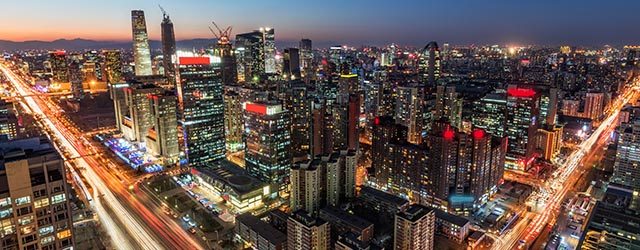The question this year for investors in China is whether the government will continue moving toward a free-market economy—or keep grabbing the wheel.

Financial reform in China, experts say, rests on three pillars: decoupling interest rates from government policy, liberalizing the capital account, and internationalizing the renminbi. The three initiatives have been on the government’s agenda since 2012, launched simultaneously under the assumption that each would develop at its own pace.

But the market turmoil of the past six months has raised doubts about Beijing’s commitment to remake financial regulation—and even about its ability to do so—while maintaining a sustainable level of GDP growth. “As seen in recent bouts of equity and currency market volatility and persistent capital outflows, we believe it is more and more difficult for the government to achieve its growth target while steering the economy to a more-balanced structure,” says Marie Diron, senior vice president of credit policy in Hong Kong for rating agency Moody’s Investor Service.
In starker language, international investors wonder whether China can stay on its avowed path toward a more free-market economy. For example, one pillar of reform, internationalization of the renminbi, recently came under pressure when exchange rate volatility widened the trading margin between onshore renminbi, known as CNY, and offshore, or CNH. The central bank’s reaction showed that intervention remains the first response to trouble.
Arbitrage in the offshore market accelerated at the beginning of the year. In early January the spread between CNY and CNH gaped to more than 2%—a record differential that the People’s Bank of China (PBOC) feared was destabilizing the currency. The bank addressed the situation by buying up CNH through state-owned commercial banks, effectively limiting the pool of offshore renminbi available for activities like short-selling. The strategy worked. By January 15, the trading band had contracted to 0.5%, and by the third week of the month, the offshore and onshore exchange rates had converged.
Shortly before they did, the central bank also imposed “normal” reserve requirement ratios (RRRs) on onshore banks with renminbi deposits from offshore banks, without specifying a percentage. Effective January 25, the RRR on such banks ceased to be zero. “Normal” is thought to mean the ratio for banks holding onshore renminbi deposits, currently 17.5% for large institutions and 15.5% for medium-size and small banks.
The PBOC’s moves look to have been successful in stabilizing the currency. But while the smackdown of speculators sends an important message, the central bank was also backing away from the laissez-faire policy it had suggested it would adopt after the IMF decided, on November 30, to include the renminbi in its Special Drawing Rights basket. The bank’s U-turn took some analysts by surprise. HSBC’s senior Asian currency strategist in Hong Kong, Ju Wang, had predicted in December that the PBOC would adopt a more “hands-off” approach to the renminbi after the SDR announcement, reducing its market-smoothing efforts to stem depreciation.
EMBARRASSING CRASH
Besides wrestling with the renminbi, the central bank has been struggling to manage stock volatility. The Chinese market meltdown on the first trading day of the year was the second collapse in six months—and an embarrassment, since the government in December had put fresh measures in place aimed at preventing crashes. As 2016 began, “we had circuit breakers on top of trading limits, limitations on index futures, limitations on market lending activities and also on margin trading,” says Bank of Communications chief strategist Hao Hong. “Yet with all these policies in place, we have more volatility, not less.”
In response, China’s cabinet created a new department to coordinate financial and economic affairs. And separately, the central bank announced it would use commercial banks’ reserve requirement ratio, previously deployed to inject liquidity into the financial system, as a tool for enforcing financial stability instead. Some experts greeted the move with skepticism. “Banks are still expected to support policy objectives and align their strategies with the state’s broad economic goals,” wrote Katie Chen, a Beijing analyst at ratings agency Fitch, in a recent note. “That suggests China remains a centrally controlled economy despite financial reforms.” The latter, Chen continued, had suggested the government would give market forces a bigger role.
Although her caution is understandable, recent events could signal better regulation in the future. The People’s Bank of China itself appears to be gaining a steadier grip on policy. Its new RRR rule “could be good news for financial reforms in China, as the PBOC has traditionally been a stronger proponent for reforms, compared to the China Banking Regulatory Commission and the China Securities Regulatory Commission,” says Xia Le, chief economist for Asia at Banco Bilbao Vizcaya Argentaria (BBVA) in Hong Kong.
DOUBLE WHAMMY
China has been on a wild ride since mid-2015, when the government responded to the August market meltdown with a sudden devaluation of the renminbi. The move drew global criticism—Goldman Sachs chief executive Lloyd Blankfein dubbed it “sloppy”—for its heavy-handedness. Other government actions were equally clumsy and haphazard: prosecuting brokers, blaming financial journalists for the market crash and forcing state-owned companies, including financial institutions, to buy stocks en masse. The consensus is that the measures failed, hurt investor confidence and probably prolonged the volatility rather than easing it.
We had circuit breakers on top of trading limits … yet with all these policies in place, we have more volatility, not less.
~ Hao Hong, Bank of Communications
Fast-forward to December. President and Communist Party general secretary Xi Jinping decided to oversee market reform himself, following last summer’s bumbling performance by premier Li Keqiang (the premier in China traditionally oversees finances and markets) and China Securities Regulatory Commission chairman Xiao Gang. Xi proclaimed a new financial era after announcing measures to stabilize markets. Three weeks later, on January 4, the Shanghai Stock Exchange’s new circuit breaker rules shut down trading for the day. The market closed again on January 7. At that point the government reversed its new measures—including the circuit breakers—and as of mid-January, investors remained tense.
A repeated blunder is unusual for Xi’s tenure, and the market chaos damaged his aura of invulnerability and cast doubt on some of his other policies. For example, investors fear the government’s anti-corruption drive has turned reckless, pursuing private-sector companies rather than concentrating on state-owned businesses, as it had before. That fear coalesced around Guo Guangchang, chairman of non-state-owned conglomerate Fosun International, who went missing for four days in December. A Twitter message that announced he had been assisting an official investigation and was traveling overseas to attend a performance of Cirque du Soleil, in which Fosun owns a 25% stake, hardly reassured shareholders. The stock has been trending down ever since—even after the chairman came home.
JUST A BLIP?
Some experts say the market turmoil interrupted a generally steady march toward real reform, especially in the banking system. In July 2013, the PBOC lifted all restrictions on commercial banks’ lending rates. It was a bold move, given that an attempt to rein in risky lending had ended up creating a credit squeeze only weeks before. Next, in April 2015, the government launched a long-awaited deposit insurance system, a key step toward deregulating domestic interest rates and introducing market- and risk-based pricing into capital allocation.

Last June, China’s State Council drafted a proposal to relax rules requiring banks to cap loan-to-deposit ratios at 75%. The proposal is likely to become law this year. When it does, banks will be able to obtain funding in interbank markets, as overseas financial institutions do. (For context, London-based Capital Economics estimates that China’s big four—ICBC, China Construction Bank, Bank of China and Agricultural Bank of China—have loan-to-deposit ratios of under 65%. The average ratio in Australia is 111%.)
In October 2015 came the PBOC’s landmark decision to remove the ceiling on bank deposit rates, allowing lenders to compete for funds against one another and against online financial wealth management products. Then, in late December—possibly as a riposte to the government’s ungainly efforts to curb market volatility—the central bank announced a new mechanism to address macro risks in the financial system, starting this year.
Rather than focusing on loans, the so-called Macro-Prudential Assessment System will enable the PBOC to evaluate a broader range of products, including bonds and equity investments. It will monitor banks’ capital adequacy and leverage ratios, asset and liability ratios, liquidity, interest rates, asset quality and foreign debt risks, in addition to managing loan growth. In a statement, the central bank defined its goal as to “more effectively guard against systemic risks, play a countercyclical role and adapt to a growing trend of asset diversification.”
“The move will strengthen the PBOC’s supervision of the entire financial system,” says BBVA’s Xia Le, who is among those who think the mechanism may have come “in response to the lack of coordination among regulators” and their “heavy-handed measures to curb the crash.”
Of course, the assessment system’s effectiveness will depend on its use. China’s central bank isn’t independent; it functions as an extension of the government, which has shown a determination to control markets. However, the PBOC now has a bigger toolkit, and other regulators have been discredited.
In this, Le sees a hopeful sign. “A strong regulator will be needed,” he says, “to manage the difficult task of limiting short-term volatility while simultaneously pushing financial deregulation forward.”
GFmag.com Data Summary: China
Central Bank: People’s Bank of China |
|||
|---|---|---|---|
|
International Reserves |
$3.9 trillion |
||
|
Gross Domestic Product (GDP) |
$11.4 trillion* |
||
|
Real GDP Growth |
2013 |
2014 |
2015* |
|
GDP Per Capita—Current Prices |
$8,280* |
||
|
GDP—Composition By Sector* |
agriculture: |
industry: |
services: |
|
Inflation |
2013 |
2014 |
2015* |
|
Public Debt (general government |
2013 |
2014 |
2015* |
|
Government Bond Ratings (foreign currency) |
Standard & Poor’s |
Moody’s |
Moody’s Outlook |
|
FDI Inflows |
2012 |
2013 |
2014 |
* Estimates
Source: GFMag.com Country Economic Reports



